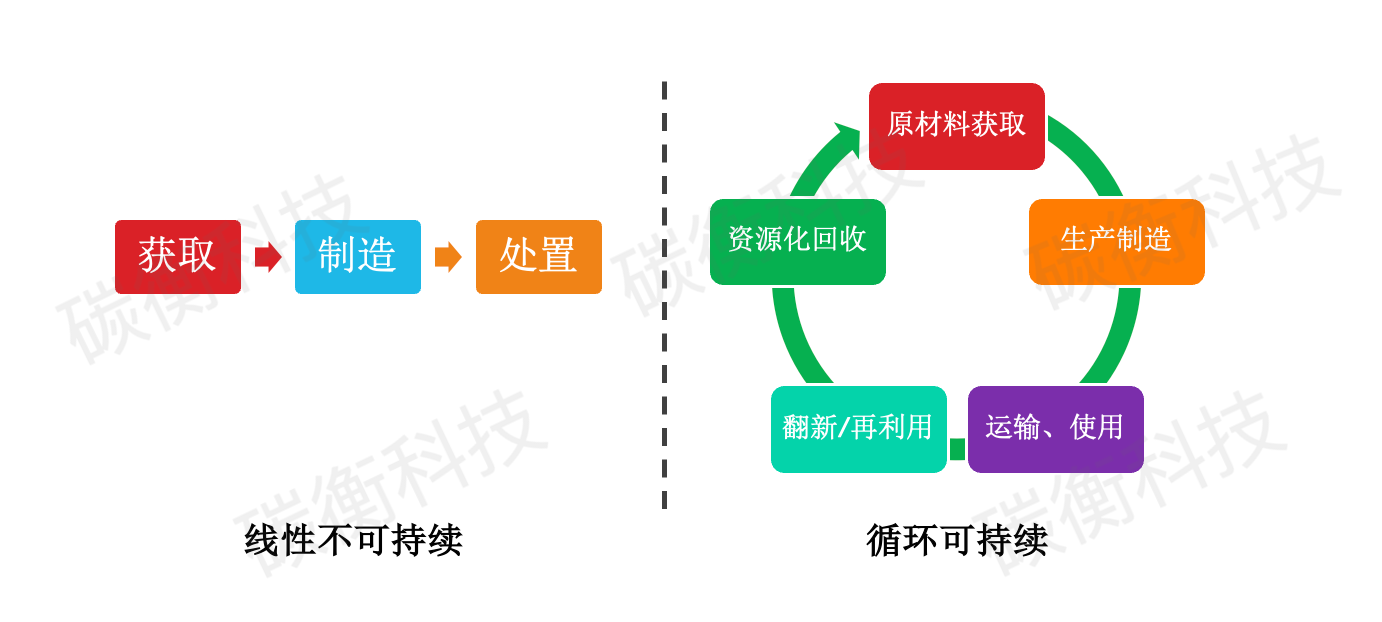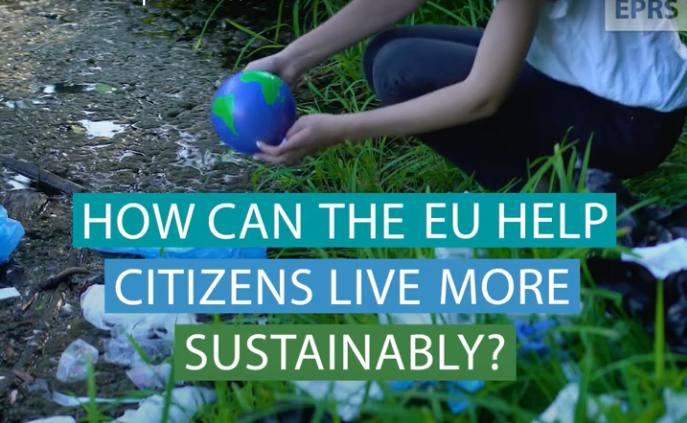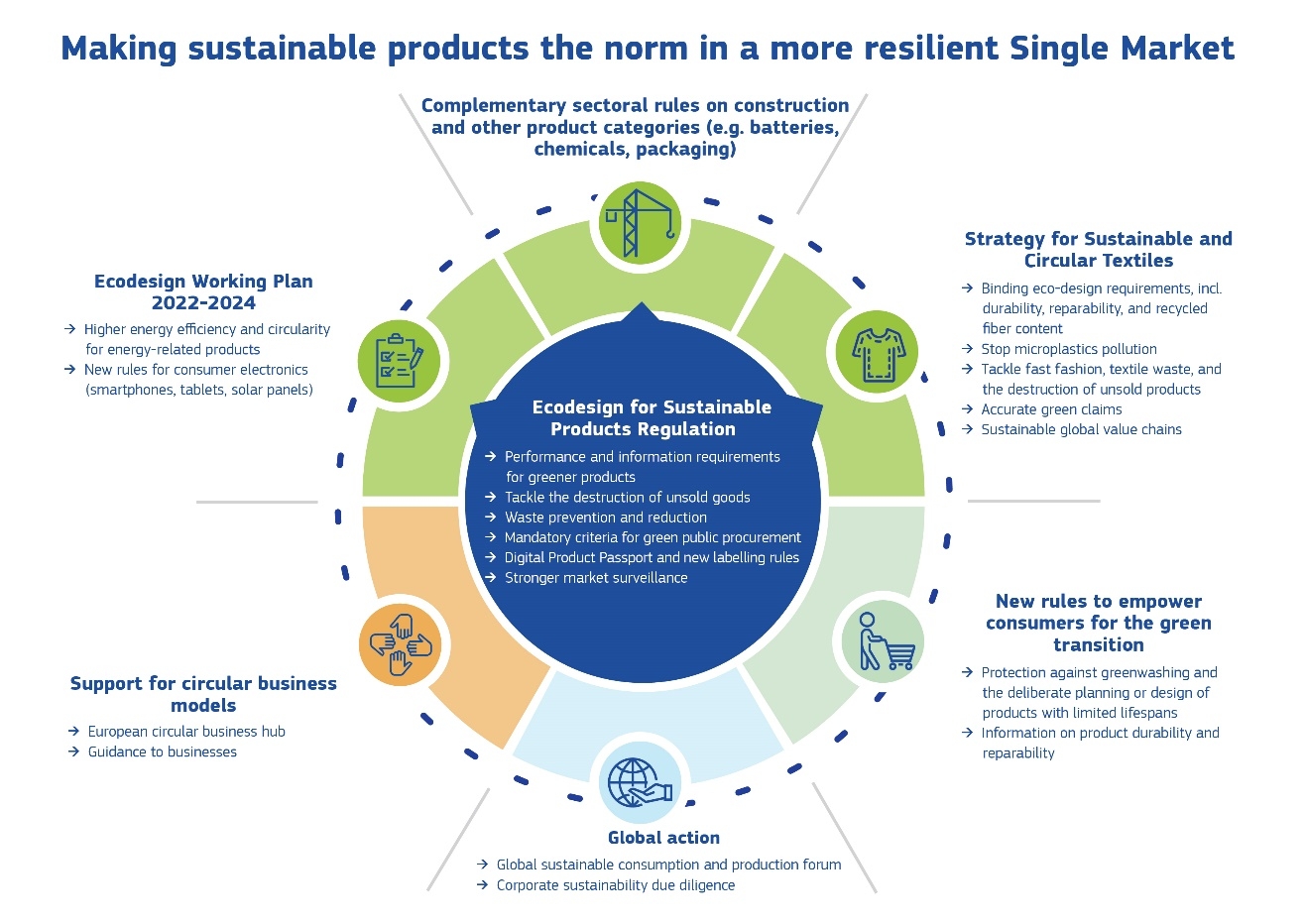On April 23, 2024, the European Parliament voted to pass the Eco-design for Sustainable Products Regulation (ESPR). ESPR mandates that products must comply with ecological design requirements to be circulated or used in the EU market. Its aim is to enhance the environmental sustainability of products and reduce their overall carbon and environmental footprints throughout their lifecycle. Additionally, ESPR sets specific requirements for product digital passports, green public procurement, and the prohibition of the destruction of unsold consumer goods.
Of note to businesses is that ESPR plans to cover all goods placed on the EU market or put into use, including components and intermediate products. Textiles (especially clothing and footwear), furniture, among others, may be among the first controlled products during the first working plan cycle in the EU (2024-2027).
01 What is eco-design, and why does ESPR require It?
Globally, half of greenhouse gas emissions and 90% of biodiversity loss are caused by the extraction and processing of primary raw materials [2]. The linear model of resource acquisition-manufacturing-disposal in traditional economic development leads to significant waste of resources. Product design determines 80% of the environmental impact throughout the product lifecycle, and ecodesign can bring significant cost savings when scaled up [3]. Therefore, designing more sustainable, circular, and energy-efficient products is the cornerstone of achieving environmental sustainability and promoting a circular economy, which is also the reason for the birth of ESPR.

Source: Carbon Newture
ESPR defines "eco-design" as the incorporation of environmental sustainability factors into the product design and value chain processes. It involves not only considering the final performance of the product but also addressing the environmental impacts throughout its entire lifecycle, including production, use, and disposal.
In contrast to traditional design approaches that focus on product features and market goals, leaving the issues of resource consumption and environmental impact to be addressed at the end of the cycle, eco-design is an important preventive measure that mitigates climate change, promotes recycling and regeneration, and enhances energy efficiency. It breaks the "cost-quality-low carbon sustainability" impossible triangle.
"Eco-design requirements" refer to specific performance or information standards that drive the achievement of environmental sustainability in the design process of products.

Source:EU Official Website,https://youtu.be/WdYrCtW-gmo
Essentially, ESPR is a revision of the existing eco-design directive (2009/125/EC) that aims to enhance its effectiveness. It is important to note that compared to the 2009/125/EC directive, ESPR expands the definition of "eco-design" by including the description of the "value chain". Furthermore, ESPR imposes specific requirements on different roles within the value chain, such as manufacturers, importers, distributors, online retailers, and repairers. For instance, manufacturers are responsible for implementing qualified assessment procedures for eco-design, while online retailers are required to collaborate with market surveillance authorities to combat non-compliant products.

Picture of EU's Circular Economy Package
From the extraction of raw materials, manufacturing, distribution, and utilization to disposal and reuse, all products are interconnected within the value chain and cannot exist independently. Therefore, any lack of cooperation within the value chain/supply chain hinders the achievement of true product sustainability. Value chain/supply chain management plays a crucial role in developing a circular economy and implementing climate plans. In the legislative proposals of the European Union's Circular Economy Package, regulations such as the "Sustainable Textile Strategy", the "New Batteries Act", and the "Empowering Consumers for the Green Transition" all emphasize the importance of the value chain and impose corresponding requirements.
02 Which industries and products will be affected?
The existing eco-design directive (2009/125/EC) primarily focuses on energy-related products, while ESPR will cover almost all products in the European Union market [1]. After ESPR comes into effect, the 2009/125/EC directive will be repealed, but certain requirements will continue to apply. For example, products such as photovoltaic panels, water heaters, air conditioners, fans, vacuum cleaners, cooking appliances, computers, servers, and data storage products will continue to adhere to the 2009/125/EC directive until the end of 2026, after which they will be subject to ESPR.
Furthermore, ESPR will release controlled product lists in batches based on the products' impact on climate, environment, energy efficiency, and economic market contribution. In the first work plan, the European Commission will prioritize products/product groups such as textiles (especially clothing and footwear) and furniture, which will be the first to be affected. Although automobiles are not directly regulated by ESPR, upstream components like steel, aluminum, and tires are within the scope of coverage.
(a) iron and steel;
(b) aluminium;
(c) textiles, in particular garments and footwear;
(d) furniture, including mattresses;
(e) tyres;
(f) detergents;
(g) paints;
(h) lubricants;
(i) chemicals;
(j) energy related products for which ecodesign requirements are to be set for the first time or for which existing measures adopted pursuant to Directive 2009/125/EC are to be reviewed under this Regulation; and
(k) information and communication technology products and other electronics.
In addition to the gradual release of product lists, ESPR will also progressively expand requirements for horizontal measures. Horizontal measures can be understood as the performance or parameter requirements that ESPR imposes on products. For example, they may include the carbon footprint related to environmental impact and a repairability rating index associated with durability.
Which horizontal measures are worth businesses planning for in advance? As listed in the following text, in addition to traditional parameters such as size, weight, noise, and energy consumption, there will be a particular emphasis on environmental impact, such as carbon footprint and environmental footprint, as well as durability and recyclability of products. These factors will be given significant attention.
(a) durability;
(b) reliability;
(c) reusability;
(d) upgradability;
(e) repairability;
(f) the possibility of maintenance and refurbishment;
(g) the presence of substances of concern;
(h) energy use and energy efficiency;
(i) water use and water efficiency;
(j) resource use and resource efficiency;
(k) recycled content;
(l) the possibility of remanufacturing;
(m) recyclability;
(n) the possibility of the recovery of materials;
(o) environmental impacts, including carbon footprint and environmental footprint;
(p) expected generation of waste.
03 Product digital passports: Digitization as an essential tool for promoting circular sustainable development
In the context of circular sustainability, traceability is crucial. Without a traceability system, it is challenging to ensure that products are truly environmentally friendly, low-carbon, and circular. Simple and efficient traceability tools not only help businesses along the value chain obtain necessary information but also enable consumers to have a better understanding of the sustainability performance of products through transparent information disclosure. For example, disclosing carbon footprint data can assist consumers in choosing lower-carbon products, subtly cultivating their green consumption habits.
Against this backdrop, the emergence of "product digital passports" that digitally record comprehensive key product information has become essential. These passports allow products to be labeled, identified, and linked to data related to their circularity and sustainability. Businesses and consumers along the value chain can quickly trace product information by accessing the digital passport (typically conveyed through QR codes, online label links, URLs, etc.) and make informed purchasing or consumption decisions. As shown in the figure, consumers can scan a QR code to trace the carbon information of a product (pet clothing).

The European Union's layout in digital traceability is becoming increasingly clear. The "Sustainable and Circular Textiles Strategy" requires textiles to provide digital passports, disclosing comprehensive sustainable information for consumers to reference, such as composition, materials, carbon footprint, etc. The "New Battery Regulation" stipulates that starting from 2027, power batteries exported to Europe must hold a compliant "battery passport" that records information such as battery manufacturers, material composition, carbon footprint, supply chain, etc.
ESPR recognizes that product digital passports are essential tools for providing information to participants in the value chain, enhancing end-to-end traceability throughout the entire value chain. Therefore, ESPR requires that product digital passports be user-friendly and provide accurate, complete, and up-to-date data.
04 Conclusion
ESPR promotes the development of the circular economy and enhances the sustainability and resilience of the global value chain by establishing a framework for sustainable product eco-design requirements. In the long run, this contributes to driving technological advancement and green transformation. However, for manufacturers and exporters in China, ensuring that their exported products meet ESPR requirements and successfully enter the European market will pose new challenges.
It is worth mentioning that ESPR will also utilize mandatory green public procurement requirements to stimulate the supply of products with better performance, higher circularity, and lower carbon footprint. China's green procurement policies are also gradually being improved, and green, low-carbon, and sustainable products will be favored in public procurement.
Note: This text is primarily based on the latest text published by the European Union on April 23, 2024. If there are slight differences from the officially legislated text, the content published in the Official Journal of the European Union should be considered authoritative.
Reference
[1]The following is outside the scope of ESPR regulation:(a) food as defined in Article 2 of Regulation (EC) No 178/2002; (b) feed as defined in Article 3(4) of Regulation (EC) No 178/2002; (c) medicinal products as defined in Article 1(2) of Directive 2001/83/EC; (d) veterinary medicinal products as defined in Article 4(1) of Regulation (EU) 2019/6; (e) living plants, animals and micro-organisms; (f) products of human origin; (g) products of plants and animals relating directly to their future reproduction; (h) vehicles as referred to in Article 2(1) of Regulation (EU) No 167/2013, in Article 2(1) of Regulation (EU) No 168/2013 and in Article 2(1) of Regulation (EU) 2018/858, in respect of those product aspects for which requirements are set under sector-specific Union legislative acts applicable to those vehicles.
[2]https://www.resourcepanel.org/reports/global-resources-outlook-2024
[3]https://op.europa.eu/en/publication-detail/-/publication/4d42d597-4f92-4498-8e1d-857cc157e6db